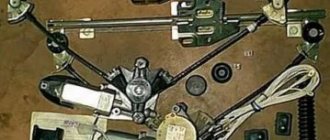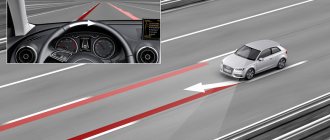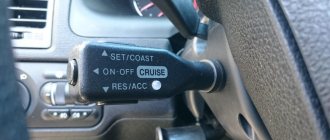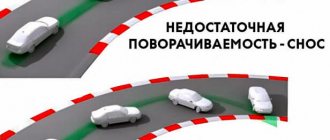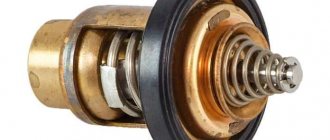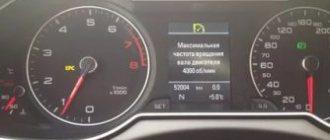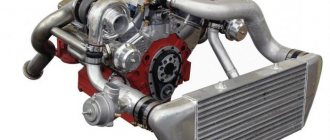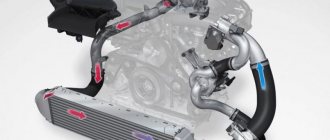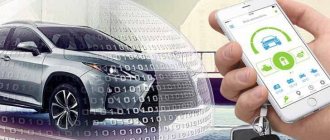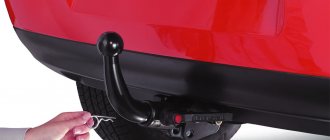(function(w, d, n, s, t) { w[n] = w[n] || ; w[n].push(function() { Ya.Context.AdvManager.render({ blockId: "RA -136785-1", renderTo: "yandex_rtb_R-A-136785-1", async: true }); }); t = d.getElementsByTagName("script"); s = d.createElement("script"); s .type = "text/javascript"; s.src = "//an.yandex.ru/system/context.js"; s.async = true; t.parentNode.insertBefore(s, t); })(this , this.document, "yandexContextAsyncCallbacks");
Traction control is the name given to the traction control system of modern cars, which is a secondary function of the electronic system. The main purpose of traction control is to ensure reliable adhesion of the wheels to the road surface.
Thanks to this system, the control process is greatly simplified while driving on wet asphalt, ice, off-road, as well as when performing various maneuvers: turns, bends, overtaking, advancing, turning around.
Principle of operation
The principle of operation is quite simple, but it was practically possible to implement it only in the early 70s. First installed on Buick cars back in 1971, its name sounded like Max-Trac.
We managed to avoid slipping in the following way:
- sensors constantly analyzed the angular speed of the wheels;
- information was sent to the electronic control unit;
- as soon as there was a discrepancy between the amount of fuel-air mixture supplied? , the speed of the vehicle itself and the speed of rotation of one of the wheels (simply put, you are accelerating, but the car does not accelerate due to slipping), traction control is activated by reducing sparking in one of the cylinders.
Later, the system was radically improved and was used on the Mercedes-Benz S-Class in 1987. Its name in German sounded like Antriebsschlupfregelung, or ASR.
The components of traction control are:
- sensors are installed on each of the wheels and monitor their rotation speed, as well as sudden increases or decreases in speed caused by slipping;
- ECU (Electronic Control Unit or electronic control unit) - processes incoming data from sensors and, in the event of signals about a sharp increase in the number of revolutions, sends electrical impulses to actuators;
- Automatic Traction Control (ATC) valves - block wheels that are spinning.
Electric valves are embedded in the main pipes through which the brake fluid circulates. As soon as an impulse is received from the electronic control unit, the valve opens, allowing the required volume of fluid to pass through, and then closes sharply to maintain the high pressure necessary to actuate the working cylinder rod and press the friction pads against the car’s brake disc. Traction control is also connected to the brake fluid return pump and the vehicle's ignition system.
(function(w, d, n, s, t) { w[n] = w[n] || ; w[n].push(function() { Ya.Context.AdvManager.render({ blockId: "RA -136785-3", renderTo: "yandex_rtb_R-A-136785-3", async: true }); }); t = d.getElementsByTagName("script"); s = d.createElement("script"); s .type = "text/javascript"; s.src = "//an.yandex.ru/system/context.js"; s.async = true; t.parentNode.insertBefore(s, t); })(this , this.document, "yandexContextAsyncCallbacks");
As you can see, the idea is simple, although its implementation requires the presence of fast processors capable of processing large amounts of information within short periods of time.
Using the traction control system in practice
It is enough to go to the official website of any car manufacturer to make sure that such auxiliary systems are widely used today - in the description of the configuration you can see so many abbreviations (TCS, BAS, ESC, EBD, ETC, VVT, A-TRC, Hill-Start, Down -Start and so on), that you need to take an English dictionary or search for a long time on the Internet for definitions of certain functions.
However, they all make driving easier and more fun.
Traction control has found wide application:
- passenger cars and cargo motorized vehicles;
- Formula 1 racing cars - they skid less on sharp turns, the speed increases accordingly, the number of accidents decreases, and new records appear;
- motorcycles - first installed on the BMW K-1, then used on Ducati and Kawasaki Concours-14;
- SUVs - traction control is often installed together with differential locking (there are also models where TCS is used independently without locking), such a solution was first implemented in 1993 on RangeRover - ABS together with TCS, according to engineers, significantly increased handling on difficult routes, and without differential locking.
Unfortunately, there are no such innovations on domestically produced cars yet. For example, the luxury version of the LADA Largus station wagon only has ABS. But the Granta Lux has ABS, Brake-Assist and EBD. We hope that the new LADA Vesta equipment will be closer to modern requirements.
(function(w, d, n, s, t) { w[n] = w[n] || ; w[n].push(function() { Ya.Context.AdvManager.render({ blockId: "RA -136785-2", renderTo: "yandex_rtb_R-A-136785-2", async: true }); }); t = d.getElementsByTagName("script"); s = d.createElement("script"); s .type = "text/javascript"; s.src = "//an.yandex.ru/system/context.js"; s.async = true; t.parentNode.insertBefore(s, t); })(this , this.document, "yandexContextAsyncCallbacks");
Let's look at the various ways to implement traction control that are used by leading motorcycle manufacturers.
Deck of cards, palm, smartphone. This is exactly the size of the spot on the rear tire of your liter sportbike. All of these are listed in the same size, which is approximately 64 square meters. cm. This entire rubber-based area should transmit more than 160 hp. and more than 80 Newton-meters of torque on the asphalt surface.
If you open the throttle too sharply, the contact patch will not be able to transmit all the power, and the tire will begin to slip. It's not over yet and the bike will start to slide, but if you are greedy and don't leave enough grip, the bike will lose traction. It should be noted that the ideal rear tire slip value is 15% higher than the front wheel speed. In other words, if you are cornering at 100 km/h, the rear wheel can rotate 115 km/h without any problems. Naturally, if you have the skills for this.
Since the tire, when slipping too much, cannot keep the motorcycle tilted, the bike begins to rotate around a vertical axis, straying from the intended trajectory. Here you have three options. You can continue to increase power to the tire and it will end up lowside. You can sharply close the throttle, thereby stopping the power supply, the contact spot will regain grip with the surface, and the motorcycle will immediately launch you like a catapult - the high-speed is more painful. Or you can fine-tune the delivery of power and torque to the rear wheel, keeping the rear wheel slip rate under control and thereby keeping the bike in a controlled drift.
Now it’s time to ask yourself: do I have the skills to keep the motorcycle sliding, and even at the peak of power and torque? My name is Nikki Hayden, Kenny Roberts, Freddie Spencer? Of course not. As a result, at least six motorcycle manufacturers (Kawasaki, Yamaha, Ducati, Aprilia, BMW and MV Agusta) now produce superbikes with factory-installed Traction Control (TC), which will tame your bike's power when needed. which he is able to transfer to the rear wheel, which means that harsh consequences can be avoided.
Although the operating principle of traction control from different manufacturers is very similar, traction control is implemented differently: different algorithms, different sensors. We've tried to understand these differences and explain how different manufacturers implement traction control on their motorcycles. In part, the manufacturer patents all the details of the traction control system and keeps it secret. Therefore, it is very difficult to gain access to the results of engineers' work.
Yamaha offers six levels of traction control adjustment
All five motorcycle manufacturers that equip their bikes with TC systems (Aprilia, BMW, Ducati, Kawasaki, Yamaha) use high-speed sensors on the wheels. These sensors were originally designed for use in ABS systems, where they have to read about 50 pulses per wheel revolution. Essentially, braking control and traction control are identical mathematical problems. In both cases, wheel slippage or wheel locking results in a difference in wheel speed. Riders tend to view acceleration and deceleration as two completely different processes, but Newton and his Laws are not so picky. A change in speed is a change in speed. The speed reduction detection sensor can easily cope with the task of detecting speed increase.
The dark horse in this group is the MV Agusta and its F4 model. Unlike others mentioned above who use wheel sensors to detect wheel slip, the Agusta monitors engine speed instead. A sharp jump in engine speed exceeding the permissible limit is dictated by preset ECU algorithms (ECU, Electronic Control Unit), and is considered as slipping of the rear wheel. Generally speaking, this is similar to those traction control systems that are installed as tuning.
It would seem easy to make a traction control system that works solely on data collected from wheel sensors. The wheel begins to rotate faster - the ECU comes into operation. This traction control system will even work in most cases. But modern liter sportbikes are more powerful than ever, and opening the throttle to 100% in 1st gear will send the user into highside. To avoid this, you need to know the throttle position, as well as the engine speed and the selected gear. Luckily, all of these bikes are fuel injected and these values are known.
Ducati: If you're brave, you can turn off the traction control completely.
If not, use smooth adjustment
electronic interference in rear wheel slip
You can stop there if you follow a minimal approach. There is data on the rotation speed of the front and rear wheels, torque value and throttle position. Kawasaki and Yamaha are of this opinion and have not added additional traction control sensors to their bikes.
Ducati engineers went a little further than the two Japanese manufacturers. They added one accelerometer that measures the longitudinal acceleration of the motorcycle. Ducati does not use information about the gear ratio used in the transmission, tire radius, etc. Engineers have bypassed this entire chain and use an accelerometer to measure longitudinal acceleration.
BMW and Aprilia go a little further than Ducati, and their traction control systems include acceleration sensors (longitudinal and lateral acceleration) and two gyroscopes. It is not yet clear how the data collected from the lateral acceleration and yaw sensors is used.
Ultimately, sensors alone are not enough for a traction control system. The traction control system must reduce slip to a safe level, do it quickly, and do it in a controlled manner. The computer reduces the slip of the driven wheel by limiting engine torque. There are three mechanisms to do this: cylinder deactivation, changing the ignition timing, or closing the throttle. Each of these methods has its own advantages and disadvantages.
1. Cylinder shutdown. This is achieved by skipping fuel injection on the intake stroke, or by supplying a spark (but this will lead to the appearance of unburned fuel in the exhaust gases, which will increase harmful emissions). Cylinder deactivation has an immediate engine response (requiring less than 180 degrees of crankshaft revolution on a 4-cylinder engine), a wide range (the torque value can be changed from 0 to 100%), but the changes will be coarse, the change increment is 25%.
2. Reducing the ignition timing. Has immediate response as well as subtle intervention. But the power can only be controlled within about 20% without causing misfire.
3. Closing the throttle (if the throttle valves are servo-controlled and Ride by Wire). There is a wide range of powers (from 0 to 100% torque drop), but, as a rule, this method has a slow response.
| Manufacturer | Sensors | Traction control mechanism |
| Kawasaki | Cylinder shutdown | |
| Yamaha | Front and rear wheel sensor | Cylinder shutdown |
| Ducati | Front and rear wheel sensor, longitudinal acceleration accelerator | Turning off the cylinders, reducing the ignition timing |
| Aprilia | Reducing the ignition timing, closing the throttle | |
| BMW | Front and rear wheel sensor, longitudinal acceleration accelerator, lateral acceleration accelerator, roll angle, yaw angle | Reducing the ignition timing, closing the throttle |
All manufacturers include an antiwheelie option in their traction control systems. Antiwheelie is the prevention of angular movement of the motorcycle around the main (horizontal) transverse axis (pitch). It would be logical to assume that this is achieved based on the information supplied by the gyroscope. But it's surprising that none of the manufacturers use this. Instead, the rotational speeds of the bike's wheels are compared. If the front wheel slows down while the rear continues to accelerate, the computer concludes that the front wheel has lost contact with the ground and orders torque reduction. Interference with the bike's ability to wheelie depends on the vehicle's settings or, in the case of the Aprilia, the anti-wheelie control setting.
The five systems discussed here were evaluated based on the number of sensors and actuators only. Kawasaki traction control is the simplest of all systems. The Yamaha is a little more sophisticated than the Greens, with a similar array of gauges but adding electronic throttle control. Ducati's sensor unit includes one inertial sensor, but no electronic throttle. Aprilia and BMW supplied the most sophisticated systems, each with electronic throttle control and four inertial sensors. We should note that complexity can be justified in any system if the development costs are offset by increased traction control capabilities.
Remember that the traction control system will not protect you 100% from situations that may arise when driving a liter sportbike without certain skills.
The abbreviation TCS stands for Traction control system and stands for traction control system or traction control system. This system has a history of more than 100 years, during which it was first used in a simplified form not only on cars, but also on steam and electric locomotives.
The deep interest of automakers in the TCS system appeared only in the second half of the 60s of the twentieth century, which was due to the arrival of electronic technologies in the auto industry. Opinions on the use of the Traction Control System are not clear, but despite this, the technology has taken root and has been actively used by all leading automakers for about 20 years. So, what is TCS in a car, why is this system needed and why is it so widely used?
The electro-hydraulic traction control system TCS is one of the car's active safety systems and is responsible for preventing slipping of the drive wheels on wet and other surfaces with reduced traction. Its task is to stabilize, level the course and improve traction with the road surface in automatic mode on all roads, regardless of speed.
Wheel slippage occurs not only on wet and frozen asphalt, but also during sudden braking, starting from a standstill, dynamic acceleration, cornering, and driving on sections of roads with different grip characteristics. In any of these cases, the traction control system will react accordingly and prevent an emergency situation.
The effectiveness of the Traction control system is evidenced by the fact that after its testing on high-speed Ferrari cars, it was adopted by Formula 1 teams and is now very widely used in motorsport.
Design and principle of operation of the TRC (TRaction Control) system
TRC (TRaction Control) is a system that simultaneously controls both the processes of braking and increasing engine traction.
This system not only eliminates slipping of the drive wheel pair, but also regulates the traction force of the engine - to values that are optimal for the specific road surface on which the car is moving. Thanks to TRC, the driver is freed from complex manipulations with the gas pedal when slipping, and the car itself acquires exceptional stability during a sharp start from a standstill or rapid acceleration on a slippery road.
However, all automakers that equip their products with traction control systems, including Toyota, which installs the TRC system on cars (for Toyota C-class it is optional, and for all classes above it is included in the basic equipment of the car), emphasize that the traction control system is not an alternative to driving wisely and safely.
In addition, manufacturers remind that how effective the traction control system, including TRC, will be depends on the condition of the road and the degree of tire wear.
These days, most traction control systems are electro-hydraulic. Of course, different manufacturers have their own know-how and traction control systems may differ slightly in design from each other. But still, in general, their principle of operation can be considered using the example of TRC.
TRC in a car controls engine thrust due to the ability to control the air damper, delaying the ignition in the cylinders (in one of them or in several at the same time). Also, TRC (TRaction Control) can increase or decrease the fuel supply to the engine and control the brake drive.
At its core, TRC is a necessary component of a car’s safety system, especially important for cars with a powerful engine, the slightest excess of traction of which leads to slipping of the drive wheels.
Without an adequately functioning TRC, a modern SUV is unthinkable, which is a priori obliged to overcome with honor both slippery and wet roads and their complete absence. Racing models cannot do without TRC; the traction control system allows them to accelerate out of turns without spinning the wheels.
Sometimes you can hear the opinion that TRC deprives an experienced driver of the control he needs over the car. Moreover, this system is not only unpopular among motorsport fans - they regularly try to outlaw TRC in some of its forms, right down to Formula 1, where, due to controversy around TRC, the rules even had to be adjusted several years ago.
However, for most car enthusiasts TRC is a reliable assistant. This system not only allows you to start or accelerate without skidding on wet or icy roads, it also makes cornering much easier for a front-wheel drive car.
It is known that on difficult turns in some cases there comes a moment when the front wheels are unable to pull the car and at the same time turn without slipping. TRC (TRaction Control) allows you to return control to the car.
Share information with friends:
Toyota VSC stability control system
What is an ESP system (ESP) in a car: the principle of operation of esp The
VSC system is responsible for the directional stability of the car while driving, which controls the signals at the output of the ABS anti-lock braking system, the traction control system and the car engine control system. Its main purpose is to bring the car out of a skid when it is moving on a slippery road, on a turn, or in a mode of sudden change in the position of the steering wheel.
The system provides control during vehicle maneuvers. Uses ABS when braking and TRC when accelerating. VSC uses electronic sensor data in combination with ABS and TRC to help manage any potential under- or over-agility in critical situations. Insufficient maneuverability leads to the fact that the car loses traction on the front wheels and tends to shift the front axle. Excessive maneuverability, on the contrary, leads to a situation where the rear wheels lose traction and the rear axle moves away from the vehicle's trajectory.
The VSC system is activated when the vehicle reaches a speed of 15 km/h or higher.
When the ignition is turned on, the warning lights for the steering system and VSC light up and go out for a few seconds. While driving, if the vehicle's wheels slip, the skid indicator light may flash while an audible warning sounds.
Engines
What is acs on a car and how does the automatic braking system work?
Under the hood, naturally aspirated gasoline engines with a displacement of 1.6 liters and a power of 110 hp could be installed. (very rare), 1.8 l - 129 hp. (1 ZZ-FE), 2.0 l – 147 hp. (1AZ-FE) and 2.4 l - 163 hp. (2AZ-FSE). The range of engines also included diesel units with a displacement of 2.0 liters and a power of 116 and 126 hp. and 2.2 liters with 148 and 175 hp.
Many owners of Toyota Avensis with gasoline engines note noticeable vibration of the engine idling - after 50-100 thousand km. Sometimes the engine mounts are to blame. But in most cases, it is not possible to determine the cause of the vibrations. The owners resort to cleaning the throttle valve, replacing spark plugs, ignition coils, and someone is trying to “change” the engine tuning program. But everything is in vain.
The most popular 1.8 liter engine turned out to have serious flaws. Motors assembled before May 2005 had a big “butter appetite” due to a design miscalculation. Oil consumption could reach up to 1 liter per 1000 km, which, you agree, is not a little. Afterwards, the design of the pistons and oil scraper rings was modified, and the disease was cured. You can curb the appetite of gluttonous engines after a “overhaul” by replacing rings and pistons. The cost of such repairs is about 35-40 thousand rubles. There is another unpleasant situation with these engines - scuffing of the connecting rod bearings on engines produced in 2007-2008 with a mileage of about 60-90 thousand km. Fortunately, such cases are few. In the presence of such a defect, the owners noted a clearly defined extraneous rattling under load in the range of 2500-3000 rpm.
“Diesel running” of the 1.8 liter engine when the engine is not warm indicates the need to replace the drive belt tensioner of the mounted units. The problem may appear after 50-100 thousand km. The cause of extraneous sounds is wear of the plastic tensioner bushings. After replacing the bushings, custom-made from caprolon, you can forget about the problem for a long time.
The 2.0 liter petrol engine is considered more demanding in terms of fuel quality, but in reality there are few problems with it. A serious problem with these engines is the breaking of the threads of the cylinder head bolts and their pulling out. True, such cases are few. The essence of the problem is that due to the pulling of the bolts, the head begins to fit loosely to the block, which leads to coolant leakage, engine overheating, etc. and so on. The cost of repairs is from 50 to 100 thousand rubles.
Also, on 2-liter gasoline engines, gasoline may begin to leak from under the “leaky” sealing ring under the fuel pressure sensor. This will be indicated by a characteristic smell in the cabin that appears when the climate control is turned on. It is recommended to replace the O-ring with a copper one.
The 2.4 liter engine is just a good boy compared to the others. All gasoline engines eventually, after 100-150 thousand km, begin to slowly take on oil, even the modified 1.8 liter. As a rule, the “buttery appetite” for 150-200 thousand km does not exceed 1-2 liters per 10,000 km.
Diesel units are generally not capricious, but they prefer only the best grades of diesel fuel. After 150-200 thousand km, you will most likely have to face the need to clean the geometry of the turbine and the EGR valve. Diesels with a displacement of 2.2 liters may also require replacement of the cylinder head gasket. In addition, 2,2D-CAT, with a catalyst, had problems until 2007 due to clogged catalyst tubes. Afterwards, the design of the tubes was changed, and a repair kit was released to replace the previously installed ones.
With a mileage of more than 100-150 thousand km, a pump (the original one costs about 3 thousand rubles), a thermostat (about 800 rubles), and a starter (brush wear - about 1600 rubles) may need to be replaced.
How the TCS traction control system works
Asr: what is it in a car, how it works, pros and cons
This wheel anti-slip system works in conjunction with the ABS system. In most cars, information is also processed in the ABS control unit, then transmitted to the engine control unit to generate control signals.
Wheel rotation sensors generate pulses, the frequency of which is proportional to the angular speed of rotation of the wheels. If the pulse frequency of the rotation sensor of any wheel significantly exceeds the pulse frequency of other wheels, therefore, the wheel has entered an uncontrolled slipping mode.
Video - how the TCS traction control system works on the UAZ Patriot:
In order to prevent this phenomenon, the TCS generates a signal that is sent to the engine control unit to reduce traction or to the ABS system to brake the corresponding wheel.
Thus, slippage can be eliminated by:
- braking the corresponding wheel by the ABS system;
- forced reduction of engine power (usually activated at high speeds);
- joint operation of two wheel torque control channels.
Adjusting (reducing) engine torque is usually done by:
- reducing fuel supply;
- adjusting the throttle valve;
- changing the ignition angle.
Antriebsschlupfregelung (ASR) system
ASR is the most common traction control system. It is installed by such flagships of the German and world markets as Mercedes, Volkswagen and Audi. The system tailored to these cars is of great help to beginners who cannot drive confidently on the road. The list of main functions includes instant differential locking, which makes it possible to feel a “loose” or “welded” differential. Through the differential lock, torque is controlled and adjusted. The electronic brain of the on-board computer processes information coming from sensors on the hubs. After instantly comparing the speed and rotation of the drive and free wheels, the system decides to slow down, increase speed and stop fuel supply.
This system involves the use of three types of work. Control of the braking system of the driving wheels, engine traction control and combined, when two methods are used at once.
The ASR system has a threshold for influencing the braking system. Usually this is 60 kilometers per hour. If this threshold is exceeded, the system will not affect the braking system to avoid dangerous situations. At high speeds, this system only affects the engine.
How to use traction control correctly?
The traction control system is an independent active safety system on Toyota cars. However, on some brand models, this module is also necessary to implement directional stability control (VSC) - when stabilization works, traction control sensors and anti-lock brake systems are used. On SUVs or crossovers, a locking differential is also used when the module operates.
Traction control is activated by default when the ignition is turned on, and the exchange rate stabilization module starts working at speeds of 15 km/h or higher. Both devices allow you to increase the vehicle's controllability on the highway, but can cause a decrease in off-road performance.
It is recommended to forcibly disable the anti-skid when driving onto unpaved or slippery surfaces, so that the electronics do not choke the engine's traction. In this case, after some time the module will automatically switch to the active state. It is not advisable to disable the anti-skid system in the city or on the highway.
ESP - operating principle and main features
This technology block combines several modules at once. These are ASR, ABS and a number of separate sensors for reading and monitoring the situation based on the angular dynamics of the car. This set of equipment is one of the most common on German cars; modules are often installed on Mercedes-Benz and VAG cars. Its main task is to control directional stability, and not to ensure a trip on a bad road.
Here are just some of the main features of ESP:
this car's traction control system is designed to monitor safe turns of the car; Even on a smooth turn, on how many roads are skidding possible, which this technology prevents; torque distribution is especially important for all-wheel drive cars, where the system’s capabilities are much greater; the ESP module cooperates with the ASR - braking system when the wheel slips; At high speed, electronic sensors also work, reducing engine speed and removing the car from a skid.
ABS also cooperates with the ESP unit, which helps prevent skidding during sudden braking on slippery roads. The ESP system sensors process a lot of important data. This is a roll, skidding, diagonal movement, stalling, uncertain braking and other data. The computer is very complex, and for its normal operation you need high quality hardware and software. So in Chinese cars, ESP causes serious problems due to the low quality of implementation.
TCS - what is this equipment in a car?
The traction control equipment called TCS goes by the full name Traction Control System. It is with this name that the device is installed on Honda cars, where it is considered a unique kit. But in fact, the operation of TCS is not much different from many other systems. The system is based on several sensors for angular velocity, wheel speed control, and road grip.
The only difference from similar systems from other manufacturers is that the Traction Control System is a conditionally independent system that does not need cooperation with other equipment in the vehicle’s active safety complex. The device uses its own compressor with brake fluid, physically braking the wheel that is out of the driver’s control. It is also possible to reduce engine torque and use these two methods simultaneously.
TRC - features and advantages of the complex
The name TRC stands for Traction Control, and this equipment is installed on Toyota vehicles. This complex also works in collaboration with other sensors in your car’s active safety systems. Toyota has made sure that TRC does not interfere with the driver's ability to perform certain turns, so the complex is not too intrusive and does not turn on if the car goes into a controlled drift.
However, this complex also has its drawbacks. If at high speed the driver presses the accelerator pedal sharply, confusion may occur when the wheel slips, and the car, instead of the planned acceleration, will nod due to a sharp decrease in engine torque. The traction force will drop, and the driver may get into an unpleasant situation. Such deficiencies occur extremely rarely.
DTC – developments of a Bavarian company
The Bavarians from BMW also do not want to use the same technologies as many other companies. They came up with the DTC - Dynamic Traction Control system. It also works on the familiar principle of controlling the transmission of torque to the wheels and always turns off. Bavarian designers foresaw that people would drive their cars in a variety of conditions, so all models are equipped with a DTC button, which forcibly turns the system on and off.
The sensor sets and DTC brains work well, and this is one of the most effective traction control systems found on modern cars. The car intelligently uses torque control and braking forces to help the driver get out of difficult situations with minimal discomfort. The equipment works perfectly at both high and low speeds.
ABS, EBD, ESC, ESP... What do these abbreviations mean and how do “assistants” work in a modern car?
We can’t live without electronics these days: they are being implemented even on such time-tested cars as UAZ and Lada 4×4. And in a modern car there are an order of magnitude more “assistants”, and each of them performs its own functions. But what exactly do electronic assistants do in a car and how can a driver understand that they are working? The answers are in our material.
ABS+EBD
Let's start with the most common “assistants” that appeared back in the 70s of the last century. At first, they were positioned exclusively as an option for executive class models (and at a price of about 10% of the cost of the car itself). We are talking about ABS (Anti-lock Braking System)
– anti-lock wheel system, which provides maximum braking force when braking, but does not lock the wheels. For what? So that the driver can control the car when braking, go around an obstacle or move into another lane.
ABS operation process
It is felt as a vibration on the brake pedal and is accompanied by a characteristic chirping sound.
To make the braking process even more effective, EBD (Electronic Brakeforce Distribution)
- electronic distribution of braking force.
Today these two systems are integral from each other and are designated as ABS+EBD
.
Brake Assist
The next stage in the development of braking systems is the emergence of Brake Assist
, "brake assistant". From the name it is clear that it helps to slow down, but how and why? After all, there are already ABS and EBD. In theory, with the advent of these systems, the accident rate should have decreased, because driving a car during emergency braking has become much easier. But after conducting a study, scientists found that in a dangerous moment, many drivers simply... do not press the brake pedal! That is, physically the car manages to stop before the obstacle, but the potential of the system is not used 100%.
Brake Assist appeared
– when you hit the brake pedal sharply, it “presses” it for you, making braking as effective as possible. How does it feel? In some car models, if you sharply hit the brake pedal and immediately release it, braking will continue for another 1-2 seconds - this is Brake Assist. But in real life it is difficult to feel his work. When the car stops during hard braking, it will simply seem that you pressed the brake hard enough and no “assistant” intervened.
Traction Control
If the previous systems are designated the same way for all cars, everyone is free to name them differently. But the essence is the same - it's a traction control system.
. It works on the same principle as ABS, but in a mirror way: this one prevents the wheels from locking when braking, and this one prevents them from slipping at the start. The same wheel rotation sensors and brake system with electronic brake force distribution are used.
How it works? Let's say you are standing on the edge of the road, the left wheel is still on the asphalt, and the right one is on the ice. At the start, the right wheel will begin to slip, and if the ice is very slippery, the car will not move - all the torque will go into slipping. Traction Control combats.
. Having detected a discrepancy in the speed of rotation of the wheels and finding that the car is standing still, and the right wheel is slipping, it will slightly “bite” it with the brakes. Thanks to this, the torque will partially go to the left wheel, and the car will be able to move away. How does it feel? In most cases, no way. The system reveals itself only by the blinking of an icon on the instrument panel, and the car confidently starts from a standstill.
At the same time, Traction Control can reduce engine speed. And this is already felt, because the driver presses on the gas, but the car does not accelerate. But as soon as the drive wheels have enough grip, Traction Control stops interfering and everything returns to normal control modes.
The system turned out to be very effective: it is installed on almost all cars, and on powerful versions it is mandatory. Traction Control received a separate development on crossovers and SUVs, because all off-road “assistants” are based on it.
ESP (Electronic Stability Program)
Having taught cars to be obedient during acceleration and braking, engineers moved on to the next problem - control of handling in extreme modes. You've probably seen many videos in which a car makes a sharp maneuver, skids and flies either into the oncoming lane or onto the side of the road. ESP prevents.
– electronic stabilization system. Some automakers also call it a dynamic stabilization system, but this does not change the essence.
The stabilization system has become the next stage in the development of electronic “assistants”, and includes both ABS and Traction Control. But unlike them, ESP works not only during acceleration or braking, but constantly. Using special sensors, the system “knows” what is happening to the car every second of movement. Where the steering wheel is turned, how hard the gas pedal is pressed, what gear is in, whether the sport driving mode is activated, etc. She is able to instantly recognize emergency situations and immediately solve problems created by the driver or external factors.
How it works? Let's say you are driving on a winter road. It looks perfectly clean, but is still covered with a thin layer of ice. At some point you make a sharp maneuver and the car goes into a skid. At a speed of 90 km/h it begins to turn across the strip. You hit the brakes, but the speed is still too high, the skid develops more... But we have ESP
! Therefore, we erase the previous picture: no skidding, no U-turn and no panic. "Crum!" – you will hear a strange sound, and the car will suddenly swerve slightly, but will calmly move on. It was ESP that recognized the beginning of a skid, activated ABS and braked individual wheels to stabilize the car. Moreover, everything happened in a split second. Instant response and excellent results.
Most drivers do not even know that in the autumn-winter period ESP can be activated several times a day, the system behaves so effectively and unnoticeably in normal driving modes. And in extreme cases it can only be replaced by a professional racing driver, and even then not in all situations. It is ESP that allows anyone sitting behind the wheel to feel like they are behind a stone wall - even a novice driver can safely drive a 500-horsepower supercar, being under the constant control of electronics.
Yes, automotive science today is ready to offer the driver a huge range of assistants - from basic ones to self-sufficient artificial intelligence. And yet, the main driver is the driver. And the “assistant” is just a very capable assistant used in modern cars, which can be found in the atlantm.by catalog.
VSC, 4LO and anti-skid unit on Toyota Land Cruiser 200 are on - what to do?
It happens that Land Cruiser 200 car owners come to the service station with a whole garland of errors on the dashboard. This means that there has been a failure in the electronic brains of the control unit.
The car must be checked with a scanner for other faults that may be hidden under this garland. If there is no serious damage to the fuel system or battery, then only flashing the electronic control unit will help.
If the USC error still appears on the Land Cruiser 200, the air filter may be clogged. It needs to be blown out and cleaned of leaves and debris that may get inside.
Principle of operation
The system helps a lot on front-wheel drive cars, but all-wheel drive cannot be discounted.
As it becomes clear, this system fights slippage.
ON a regular car, if one wheel is stuck, it spins helplessly, the second is engaged, but does not push the car. In the end, you stand and grind.
With “anti-skid” (whether it is TSC, TRC, ASR or others, it doesn’t matter) - if one wheel starts to slip and the second one is stationary (the car is not moving), information is read using sensors and other things. The electronics decide to slow down the slipping wheel (usually with brake pads) and transfer the torque to the second one, which has good traction.
Thanks to this, the machine gets out of snow drifts or mud more efficiently.
However, the setting must be adequate and very fine, otherwise it will not work normally, but on the contrary, a lot of problems will appear (but more on that below)
External links
- Traction control in Formula One
Mazda MX-5 Integrated System Vehicle Dynamics Robert Bosch GmbH TCS Automotive Safety Cadillac Eldorado Electronic Stability Control Nissan Navara TC All Wheel Drive Ford Explorer Chrysler New Yorker Noble Automotive Mitsubishi Diamante Alfa Romeo 156 Eagle Vision Chrysler Concorde BMW 5 Series (E39) Honda Legend 2 001 Spanish Grand Prix Mitsubishi Outlander Step Hyundai Getz 4Matic
Abstract on the topic:
In Toyota cars TRC OFF - what is this button and how to use it
p, blockquote 27,0,0,0,0 —>
In order to disable the stabilization system, as already mentioned, the driver will need to press the button labeled “TRC off” on the center console of your Toyota. This should be done as consciously as possible - only if wheel slip is really a necessary condition.
p, blockquote 28,0,0,0,0 —>
p, blockquote 29,0,0,1,0 —>
In addition to the above-mentioned off-road driving, it also makes sense to disable the traction control in cases where intensive acceleration of the car is necessary (for example, to overcome difficult sections on the road by “moving”).
p, blockquote 30,0,0,0,0 —>
It is worth mentioning separately the fact that in the Toyota crossover TRC is not completely disabled, that is, pressing the “TRC off” key only briefly deactivates the system. In addition, the system automatically turns on when the speed reaches 40 kilometers per hour, as indicated by the inscription “TRC on” on the dashboard.
p, blockquote 31,0,0,0,0 —> adsp-pro-2 —>
Accordingly, if you need to turn it off again, the button will have to be pressed again.
This precaution by the manufacturer is justified by safety standards, since today traction control is considered one of the most effective safety systems
p, blockquote 32,0,0,0,0 —>
In fact, this statement is supported by statistics on road accidents in different countries, and many independent organizations are lobbying for the introduction of legislation requiring the use of TRC systems on all cars sold on the market, regardless of configuration.
p, blockquote 33,0,0,0,0 —>
Advantages and disadvantages of modern Traction Control Systems
Modern traction control systems have a number of advantages and disadvantages. The first, of course, includes greater driving safety, because the system itself is capable of “recognizing” the risk of skidding and extinguishing its development.
On the other hand, such “assistance” relaxes the driver, which can lead to less caution when driving on slippery surfaces. In addition, do not forget about situations where wheel slip is not evil, but, on the contrary, can be a driver’s assistant.
By the way, this statement does not apply to fans of drifting and high-speed driving on race tracks, but to those drivers who often drive off-road or in deep snow. For example, traction control and anti-skid systems can play a cruel joke if you decide to overcome the “pull” of virgin snow.
By artificially limiting the speed, the system is able to turn off the car’s engine at the most crucial moment, and such a “gift” will end in the search for a tractor. To avoid such unpleasant situations, almost all automakers provide the ability to disable traction control, for which a separate button is used on the car’s center console.
As a rule, it is marked with a corresponding designation (on the same Toyota crossovers it is “TRC off”). Using the key, you can deactivate the system in order to successfully overcome a difficult area.
Using traction control in real operation
h23,0,0,0,0—> p, blockquote23,0,0,0,0—>
Despite the fact that many modern cars have a traction control option, not all drivers know how to use this system. Let's try to figure out how to use the traction control system using the example of a Toyota RAV-4.
p, blockquote24,0,0,0,0—>
In normal driving mode, the “default” so to speak, the TRC system on Toyota is constantly activated. Its intervention in control is completely invisible at first glance, but when one or more wheels of the car hit a slippery section of the road, the system comes into action, “directing” the car in the desired direction and preventing the development of a skid.
p, blockquote25,0,0,0,0—>
In practice, this can be noticed by the selective activation of the anti-lock brake system, which is accompanied by a characteristic crunch, as well as a decreasing response to the gas pedal. In addition, a corresponding indicator flashes on the dashboard, indicating that the system is activated.
p, blockquote26,0,0,0,0—>
The ASR system and the nuances of its operation
ASR helps prevent loss of traction in a vehicle's wheels by using an electro-hydraulic system that controls the engine and brakes in adverse road conditions or if the driver uses excessive acceleration and the wheels begin to slip on the pavement. The ASR system helps the driver avoid making mistakes in adverse road conditions and helps the driver maintain control of the vehicle.
Professional drivers complain that ASR affects vehicle performance, but this standard equipment in high-performance vehicles helps beginners and drivers who often overestimate their ability to control the vehicle in adverse weather conditions, and restores driver control in unexpected circumstances.
ASR technology has been in most cars and motorcycles since about 1992. And it dates back to the early 1930s, when Porsche developed a limited-slip differential, which allows one wheel to spin slightly faster than the other to improve traction. The ASR system is closely related to ABS. The first users of ASR, which was already complemented by an ABS system, were BMW in 1979.
Traction control components
Usually the main hardware for traction control and ABS are mostly the same. Many vehicles provide traction control as an optional extra on ABS.
- Each wheel is equipped with a sensor that senses changes in its speed due to loss of traction.
- The perceived speed from the individual wheels is transferred to the electronic control unit (ECU).
- The ECU processes information from the wheels and dedicated braking to the affected wheels through a cable connected to the automatic traction control (ATC) valve.
All vehicles automatically initiate traction control when sensors detect loss of traction in any wheel.
ASR / Traction Control - what is it?
p, blockquote 5,0,0,0,0 —>
So, let's figure out what traction control is? In simple terms, this is a system that includes a clutch that redistributes torque between the driving wheels of the car, an anti-lock braking system that selectively brakes the wheels, as well as a set of sensors with a control unit that coordinates the actions of these devices to dampen car skidding and wheel slip.
p, blockquote 6,0,0,0,0 —>
In fact, today traction control combines the capabilities of anti-skid and anti-slip systems, although it was originally created as an effective tool to combat slippage.
p, blockquote 7,0,0,0,0 —>
It is a well-known fact that the first automobile brand to commercially introduce traction control in cars was the American company Buick, introducing a system called MaxTrac in 1971.
p, blockquote 8,0,0,0,0 —> adsp-pro-1 —>
The operation of the system was aimed at preventing slipping of the drive wheels, and the control unit, using sensors, detected the slipping and sent a signal to reduce engine speed by interrupting the ignition in one or more cylinders, that is, it “choked” the engine.
p, blockquote 9,0,1,0,0 —>
This scheme turned out to be very tenacious and is used today by almost all automakers. However, at that time the traction control system did not have the function of dynamic vehicle stabilization.
p, blockquote 10,0,0,0,0 —>
Japanese engineers from the Toyota concern played a significant role in the development of the Traction Control system (abbreviated as TRC). It was they who were one of the first to come up with the idea of using the principles embedded in the system to stabilize the car in the event of an emergency.
p, blockquote 11,0,0,0,0 —>
Video - Toyota company explains how traction control works:
p, blockquote 12,0,0,0,0 —>
p, blockquote 13,0,0,0,0 —>
What distinguishes TRC from Toyota is its comprehensive approach to system design, which includes angular velocity sensors in the car’s wheels, monitoring the rotation speed of each wheel, and the use of comprehensive traction reduction methods.
p, blockquote 14,0,0,0,0 —>
In the first versions of passenger cars, traction was also reduced by “strangling” the engine, and in modern versions of the system installed on modern crossovers (for example, the popular Toyota RAV-4), a selective reduction in the speed of rotation of one or another wheel is carried out using a standard viscous coupling , which receives signals from the central control unit of the system.
p, blockquote 15,0,0,0,0 —>
In this case, the viscous coupling does not reduce the torque on the slipping wheel, but proportionally increases the amount of torque on the wheel that has better traction. In this “forceful” way, the car returns to the required trajectory and there is no danger of developing a skid, but in the direction opposite to the slippery surface.
p, blockquote 16,0,0,0,0 —>
Links[edit]
- "Max Track". www.buick-riviera.com. Retrieved November 26, 2013.
- ^ a b
"Ford Expedition 2003". www.ford-trucks.com. Retrieved September 14, 2012. - "Expedition chassis". www.media.ford.com. Archived from the original on 2013-03-19. Retrieved November 8, 2012.
- "2012 Ford Ford Police Interceptor/Interceptor Utility - First Drive Review". www.caranddriver.com. Archived from the original on January 18, 2013. Retrieved September 14, 2012.
- "2013 Ford Expedition". www.Ford.com. Retrieved September 14, 2012.
- "2008 Porsche Cayenne". www.fourwheeler.com. Retrieved September 14, 2012.
- "Car #1 NWSMT Team Punished for Rule Violation". September 17, 2008. Retrieved November 7, 2021.
